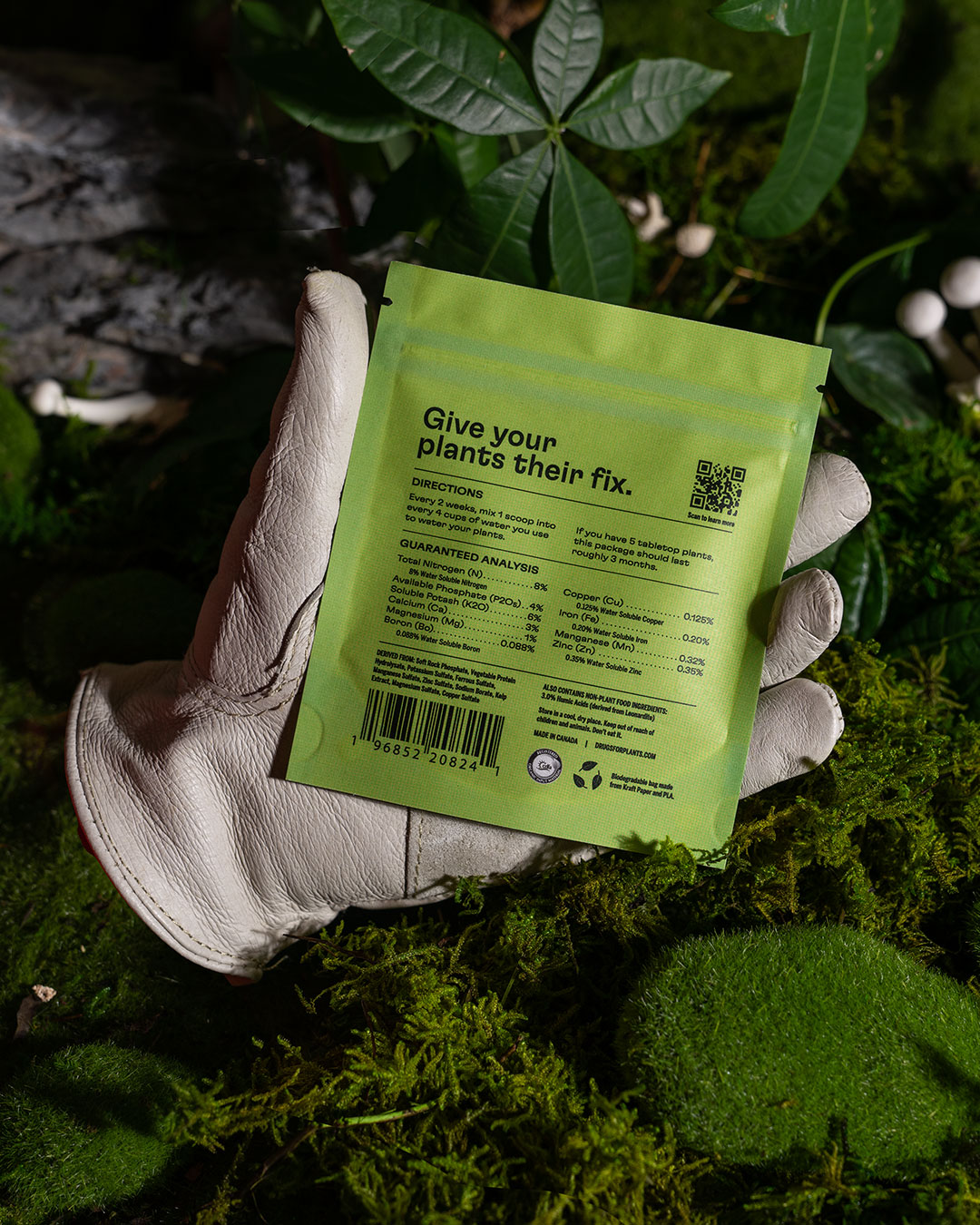

What's in the bag?
Our plant fertilizer powder is a potent mixture of macronutrients and micronutrients that have been balanced to promote growth in any plant that wasn't originally found in a desert.
MACRONUTRIENTS
Collapsible content
NITROGEN 8.00%
Nitrogen helps plants grow bigger.
When plants are nitrogen deficient, they appear starved. They are thin and pale and their growth is stunted.
Chlorophyll development also requires enough nitrogen, so, without nitrogen leaves may appear yellow or pale green, and they tend to remain small and drop prematurely.
PHOSPHATE 4.00%
Phosphorus is required for the proper growth and development of all plants, but especially seedlings. That's why it's often recommended as a starter fertilizer to enhance the early growth of plants.
That being said, it is also important to have adequate phosphorus throughout the entire lifecycle because plants use it for energy as they grow, especially when producing flowers.
Phosphorus deficiency is the most common soil deficiency. This can cause root and shoot growths that are stunted, with shoots appearing spindly and leaves appearing abnormally dark in color. In severe cases, leaves may develop a reddish-purple color. Phosphorus deficiency can also cause a lack of flower production, delayed maturity, and poor winter resilience.
POTASH 6.00%
Potassium, called potash when it's water-soluble, is responsible for the proper movement of water, carbohydrates, and nutrients through plant tissue. It also plays a vital role in the energy of the plant, which affects photosynthesis.
Adequate potassium enhances the stress resistance and rigidity of plants, increasing survival and protecting against harsh conditions.
Plants deficient in potassium are more susceptible to injury and disease. Also, since potassium plays a critical role in water movement, a deficiency can cause stunted growth, yield reduction, wilting, and premature defoliation. The shelf-life of harvested flowers may also be reduced during low potassium, and lower leaves often develop white, yellow, or brown spots.
MICRONUTRIENTS
Collapsible content
CALCIUM 3.00%
Calcium signals the growth of plant roots and shoots and is crucial for the incorporation of cell wall components. A calcium deficiency may present as leaf curling, fruit cracking, or inferior root growth.
HUMIC ACID 3.00%
Humic and fulvic acids are natural components of soil that are produced from the breakdown of microbial, plant, and animal material. These compounds are vital contributors to soil fertility and work in the soil to enhance the growth and development of plants. They do this by enhancing the plant’s uptake of micro and macronutrients and by increasing the availability of phosphorus. Some evidence also suggests humic and fulvic acids play a role in protecting plants from certain environmental stresses like drought or cold temperatures.
MAGNESIUM 1.00%
Magnesium enhances root formation, chlorophyll synthesis and pigmentation, and regulates cell turgor or rigidity.
BORON 0.088%
Boron is required for proper reproductive and vegetative growth. It is responsible for root and shoot growth and development, pollen development, and fruit and flower production. Boron deficiency first appears as yellowing of new leaves and can progress to the formation of thick, brittle branches and short stubby roots.
COPPER 0.125%
Copper is an essential metal required for proper photosynthesis. When used as a nutrient, only very small amounts are required, as copper may persist in the soil for many years. Copper deficiency affects young leaves and reproductive organs and worsens as soil pH increases. Soil without adequate copper content may cause light green or yellow leaves, reduced flowering, as well as malformed and/or necrotic leaves.
IRON 0.20%
Iron plays a critical role in respiration and photosynthesis and is required for the proper growth of all plants. Acidic soils and waterlogged soils tend to have the highest natural iron content. Iron deficiencies are quite common and may lead to yellowing leaves and poor root formation. A certain level of iron is required for all plants in order to properly grow.
MANGANESE 0.32%
Manganese enhances the efficiency of photosynthesis, which boosts growth, yield, and quality. Manganese optimizes the plant’s usage of the three primary macronutrients. Manganese deficiency affects the chloroplast of the plant’s cells and results in severely diminished quality.
ZINC 0.35%
Zinc is crucial for the production of many plant growth regulators. It enhances yields, improves resistance to injury, and improves production of flowers. In zinc deficiency, growth may cease and plants become more susceptible to injury. Small, malformed leaves with necrotic spots and stunted roots are the characteristic signs of a zinc deficiency.
SEAWEED EXTRACT
Seaweed enhances water retention and aeration, and protects against heavy metal stress. In plants, seaweed has been shown to enhance seed germination, plant establishment, and growth. Certain protective components have also been found in seaweed, suggesting a potential role in environmental stress protection.
PROTEIN HYDROLYSATES
Protein hydrolysates provide nitrogen to growing plants. Protein hydrolysates may also contribute to soil fertility, and both compounds have been shown to enhance nutrient acquisition by roots of treated plants.